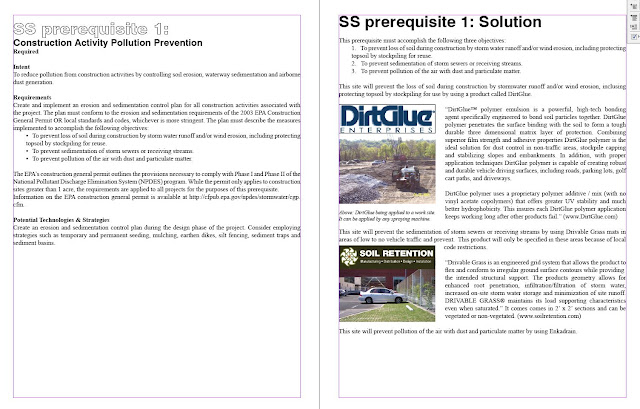I would like to thank my professors for not allowing me to give up and pushing me to my limits. They have always helped me to realize my full potential. I would like to thank Matthew Garvie for always supporting me and encouraging me through this difficult process. And finally, I would like to thank my parents for helping me understand the importance of education. They have always supported me to do my best wherever that path may lead me.
Introduction
The LEED rating system is the most comprehensive rating system we have to date. It was developed in 1994 and has become more inclusive ever since. It takes into account Sustainable Sites, Water Efficiency, Energy and Atmosphere, Materials and Resources, Indoor Environmental Quality, Innovation in Design Process and Regional Priority Credits. It is a point scale for certification ranges from 40 points and above.
Certified 40 - 49 Points
Silver 50-59 Points
Gold 60 - 79 Points
Platinum 80 Points and above
Typical Page Consists of the Credit or Prerequisite on the Left hand side and the Solution to the Credit or Prerequisite on the Right hand side.
SS prerequisite 1:
Construction Activity Pollution Prevention
Required
Intent
To reduce pollution from construction activities by controlling soil erosion, waterway sedimentation and airborne dust generation.
Requirements
Create and implement an erosion and sedimentation control plan for all construction activities associated with the project. The plan must conform to the erosion and sedimentation requirements of the 2003 EPA Construction General Permit OR local standards and codes, whichever is more stringent. The plan must describe the measures implemented to accomplish the following objectives:
• To prevent loss of soil during construction by storm water runoff and/or wind erosion, including protecting topsoil by stockpiling for reuse.
• To prevent sedimentation of storm sewers or receiving streams.
• To prevent pollution of the air with dust and particulate matter.
The EPA’s construction general permit outlines the provisions necessary to comply with Phase I and Phase II of the National Pollutant Discharge Elimination System (NPDES) program. While the permit only applies to construction sites greater than 1 acre, the requirements are applied to all projects for the purposes of this prerequisite.
Information on the EPA construction general permit is available at http://cfpub.epa.gov/npdes/stormwater/cgp.cfm.
Potential Technologies & Strategies
Create an erosion and sedimentation control plan during the design phase of the project. Consider employing strategies such as temporary and permanent seeding, mulching, earthen dikes, silt fencing, sediment traps and sediment basins.
SS prerequisite 1: Solution
This prerequisite must accomplish the following three objectives:
1. To prevent loss of soil during construction by storm water runoff and/or wind erosion, including protecting topsoil by stockpiling for reuse.
2. To prevent sedimentation of storm sewers or receiving streams.
3. To prevent pollution of the air with dust and particulate matter.
This site will prevent the loss of soil during construction by stormwater runoff and/or wind erosion, inclusing protecting topsoil by stockpiling for use by using a product called DirtGlue.
“DirtGlue™ polymer emulsion is a powerful, high-tech bonding agent specifically engineered to bond soil particles together. DirtGlue polymer penetrates the surface binding with the soil to form a tough durable three dimensional matrix layer of protection. Combining superior film strength and adhesive properties DirtGlue polymer is the ideal solution for dust control in non-traffic areas, stockpile capping and stabilizing slopes and embankments. In addition, with proper application techniques DirtGlue polymer is capable of creating robust and durable vehicle driving surfaces, including roads, parking lots, golf cart paths, and driveways.
DirtGlue polymer uses a proprietary polymer additive / mix (with no vinyl acetate copolymers) that offers greater UV stability and much better hydrophobicity. This insures each DirtGlue polymer application keeps working long after other products fail.” (www.DirtGlue.com)
This site will prevent the sedimentation of storm sewers or receiving streams by using Drivable Grass mats in areas of low to no vehicle traffic and prevent. This product will only be specified in these areas because of local code restrictions.
“Drivable Grass is an engineered grid system that allows the product to flex and conform to irregular ground surface contours while providing
the intended structural support. The products geometry allows for enhanced root penetration, infiltration/filtration of storm water, increased on-site storm water storage and minimization of site runoff. DRIVABLE GRASS® maintains its load supporting characteristics even when saturated.” It comes comes in 2’ x 2’ sections and can be vegetated or non-vegetated. (www.soilretention.com)
This site will prevent pollution of the air with dust and particulate matter by using Enkadrain.




No comments:
Post a Comment